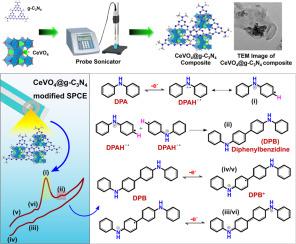Cerium vanadate/graphitic carbon nitride nanocomposite for electrochemical detection of diphenylamine
IF 5.7
3区 材料科学
Q2 MATERIALS SCIENCE, MULTIDISCIPLINARY
引用次数: 0
Abstract
Physiological storage issues in fruits often result from inadequate post-harvest handling. Diphenylamine (DPA), commonly used to prevent surface scald, may leave toxic residues, necessitating precise detection. In this study, cerium orthovanadate (CeVO4) was synthesized via a hydrothermal route and characterized using XRD, FTIR, HRTEM, and XPS. A CeVO4@g-C3N4 nanocomposite was fabricated and drop-cast onto a screen-printed carbon electrode (SPCE) for electrochemical sensing of DPA. Sensor performance was evaluated using EIS, CV, and DPV, along with optimization of catalyst loading, scan rate, pH, and stability. The CeVO4@g-C3N4-modified SPCE showed a wide linear detection range (0.01–792.0 µM), low detection limit (1.1 nM), and high sensitivity. Real fruit sample analysis demonstrated high recovery and reliability. The study's novelty lies in the use of CeVO4@g-C3N4 as a sensitive and reproducible sensing interface, offering a practical platform for DPA detection in food safety monitoring.

钒酸铈/石墨氮化碳纳米复合材料电化学检测二苯胺
水果的生理贮藏问题往往是采后处理不当造成的。通常用于防止表面烫伤的二苯胺(DPA)可能会留下有毒残留物,需要精确检测。本研究采用水热法合成了正钒酸铈(CeVO4),并用XRD、FTIR、HRTEM和XPS对其进行了表征。制备了CeVO4@g-C3N4纳米复合材料,并将其滴铸到丝网印刷碳电极(SPCE)上,用于DPA的电化学传感。通过EIS、CV和DPV对传感器性能进行评估,并对催化剂负载、扫描速率、pH和稳定性进行优化。CeVO4@g-C3N4-modified SPCE线性检测范围宽(0.01 ~ 792.0µM),检出限低(1.1 nM),灵敏度高。结果表明,该方法具有较高的回收率和可靠性。本研究的新颖之处在于利用CeVO4@g-C3N4作为灵敏、可重复的传感接口,为食品安全监测中的DPA检测提供了一个实用的平台。
本文章由计算机程序翻译,如有差异,请以英文原文为准。
求助全文
约1分钟内获得全文
求助全文
来源期刊

Materials Research Bulletin
工程技术-材料科学:综合
CiteScore
9.80
自引率
5.60%
发文量
372
审稿时长
42 days
期刊介绍:
Materials Research Bulletin is an international journal reporting high-impact research on processing-structure-property relationships in functional materials and nanomaterials with interesting electronic, magnetic, optical, thermal, mechanical or catalytic properties. Papers purely on thermodynamics or theoretical calculations (e.g., density functional theory) do not fall within the scope of the journal unless they also demonstrate a clear link to physical properties. Topics covered include functional materials (e.g., dielectrics, pyroelectrics, piezoelectrics, ferroelectrics, relaxors, thermoelectrics, etc.); electrochemistry and solid-state ionics (e.g., photovoltaics, batteries, sensors, and fuel cells); nanomaterials, graphene, and nanocomposites; luminescence and photocatalysis; crystal-structure and defect-structure analysis; novel electronics; non-crystalline solids; flexible electronics; protein-material interactions; and polymeric ion-exchange membranes.
 求助内容:
求助内容: 应助结果提醒方式:
应助结果提醒方式:


